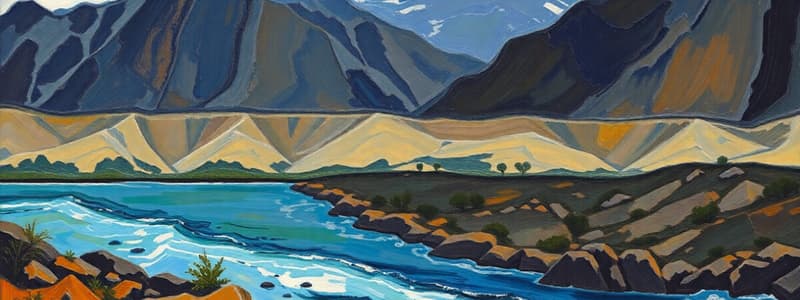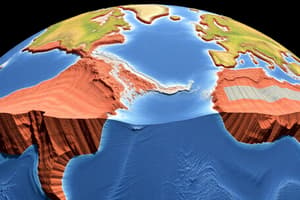Podcast
Questions and Answers
What is the primary characteristic of continental crust compared to oceanic crust?
What is the primary characteristic of continental crust compared to oceanic crust?
- It has a greater depth than oceanic crust.
- It is younger and thinner than oceanic crust.
- It is more dense than oceanic crust.
- It is older and thicker than oceanic crust. (correct)
Which type of plate boundary is characterized by plates moving away from each other?
Which type of plate boundary is characterized by plates moving away from each other?
- Destructive Plate Boundary
- Constructive Plate Boundary (correct)
- Transform Plate Boundary
- Conservative Plate Boundary
At which type of plate boundary do two tectonic plates collide?
At which type of plate boundary do two tectonic plates collide?
- Conservative Plate Boundary
- Constructive Plate Boundary
- Destructive Plate Boundary (correct)
- Divergent Plate Boundary
Which of the following statements is true regarding oceanic crust?
Which of the following statements is true regarding oceanic crust?
What happens at a conservative plate boundary?
What happens at a conservative plate boundary?
Flashcards are hidden until you start studying
Study Notes
Plate Boundaries
- Tectonic plates meet at plate margins.
- Two types of crust: continental and oceanic.
- Continental crust is older, thicker, and less dense than oceanic crust.
- Oceanic crust is younger, thinner, and denser than continental crust.
Types of Plate Boundaries
- Destructive plate boundary is where two plates collide.
- Constructive plate boundary is where two plates move apart.
- Conservative plate boundary is where two plates slide past each other.
Studying That Suits You
Use AI to generate personalized quizzes and flashcards to suit your learning preferences.




